Navigating the journey of academic success for children with autism can feel like a rollercoaster ride, filled with unique challenges and opportunities. One shining light in this journey is Applied Behavior Analysis (ABA) therapy. It’s not just about boosting academic skills; it’s about nurturing overall development too! By customizing learning experiences to fit each child’s needs, ABA therapy can really ramp up engagement and performance in school settings.
But here’s the big question: how can parents and educators tap into these strategies to pave the way for lasting success? In this article, we’ll dive into ten impactful ways ABA therapy can transform academic skills for children with autism. Let’s explore this together and uncover insights and actionable strategies that can lead to a brighter educational future!
At Rori Care - ABA Therapy, we understand that every child is unique, and that’s why we use data-driven techniques to craft individualized educational plans tailored to each student’s specific needs. Our passionate clinicians are here to support your family with comprehensive and compassionate Applied Behavior Analysis treatment. By taking the time to evaluate each child’s strengths and challenges, our qualified behavior analysts develop focused strategies, such as aba therapy for improving academic skills, that not only enhance educational outcomes but also promote positive behavior changes and skill acquisition. And guess what? We offer a complimentary consultation to chat about how our services can help your son or daughter!
For instance, think about a young learner who’s having a tough time with reading. They might thrive with a plan that includes visual aids and interactive reading sessions, all designed to match their learning style. This personalized approach, such as aba therapy for improving academic skills, doesn’t just boost educational success; it also helps build confidence as kids engage with their learning materials in a way that resonates with them. With a commitment to continuous assessment and adjustment, Rori Care ensures that each therapy session is responsive to your child’s evolving needs, empowering you as caregivers with ABA principles to support your loved ones' behavioral goals.
Research shows that implementing aba therapy for improving academic skills can lead to a significant increase in student engagement and improvement in educational achievement. This really highlights how important personalized approaches, including aba therapy for improving academic skills, are in fostering educational success for young individuals with autism. So, let’s explore this together! We’re here to help you every step of the way!

Individualized Education Programs (IEPs) are such important tools for helping individuals with autism thrive in their educational journeys. These plans are carefully designed to meet each person's unique needs, laying out specific goals, accommodations, and services that pave the way for academic success. For instance, an IEP might include things like extra time for tests or the use of assistive technology to make learning more engaging and effective.
Collaboration is key! When parents, educators, and therapists come together, they create a powerful support system that truly understands the individual’s strengths and challenges. This teamwork ensures that the IEP can evolve as the person grows, adapting to their changing needs. Regular check-ins and updates are super important, too, as they help keep the goals relevant and achievable, ultimately supporting the student’s academic journey and personal growth. Research shows that personalized IEPs and ABA therapy for improving academic skills can significantly boost educational and social outcomes for individuals with autism, making this collaborative effort even more impactful.
Let’s explore this together! If you’re navigating the IEP process, remember that you’re not alone. We’re here to help you every step of the way!
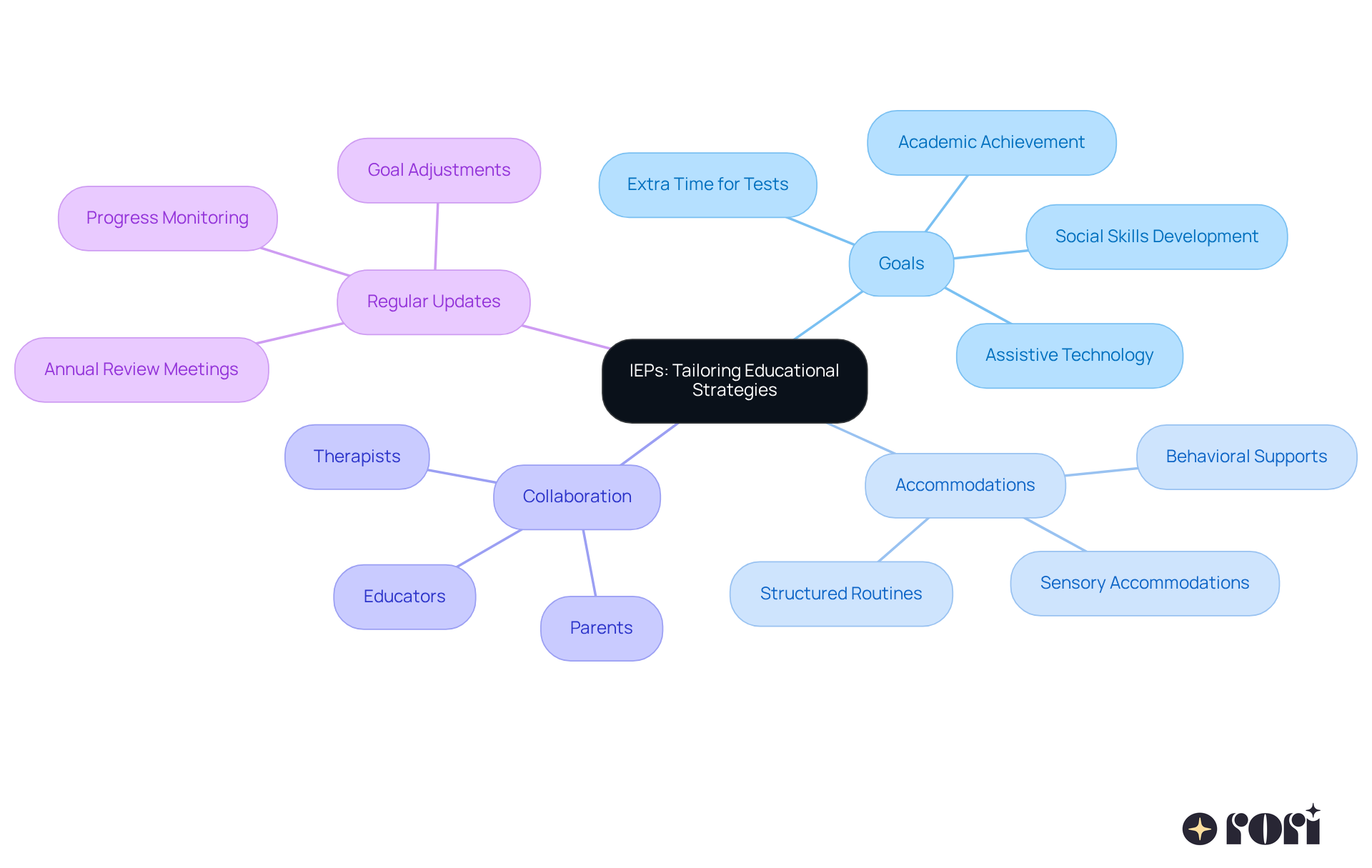
Visual aids like charts, diagrams, and visual schedules play a crucial role in ABA therapy, offering structured guidance that really helps individuals with autism. These tools break down complex tasks into manageable steps, making it easier to understand and follow instructions. For example, visual schedules allow children to anticipate their daily activities, which can ease anxiety and boost focus.
Research shows that using visual aids regularly enhances understanding and retention, leading to better performance in studies. Plus, these aids not only help reduce challenging behaviors but also encourage independence and participation in educational activities. By tailoring these supports to each student’s unique needs, therapists can create a more effective learning environment that promotes success in school settings.
Let’s explore this together! If you’re a parent navigating these challenges, remember that you’re not alone. We’re here to help you every step of the way!
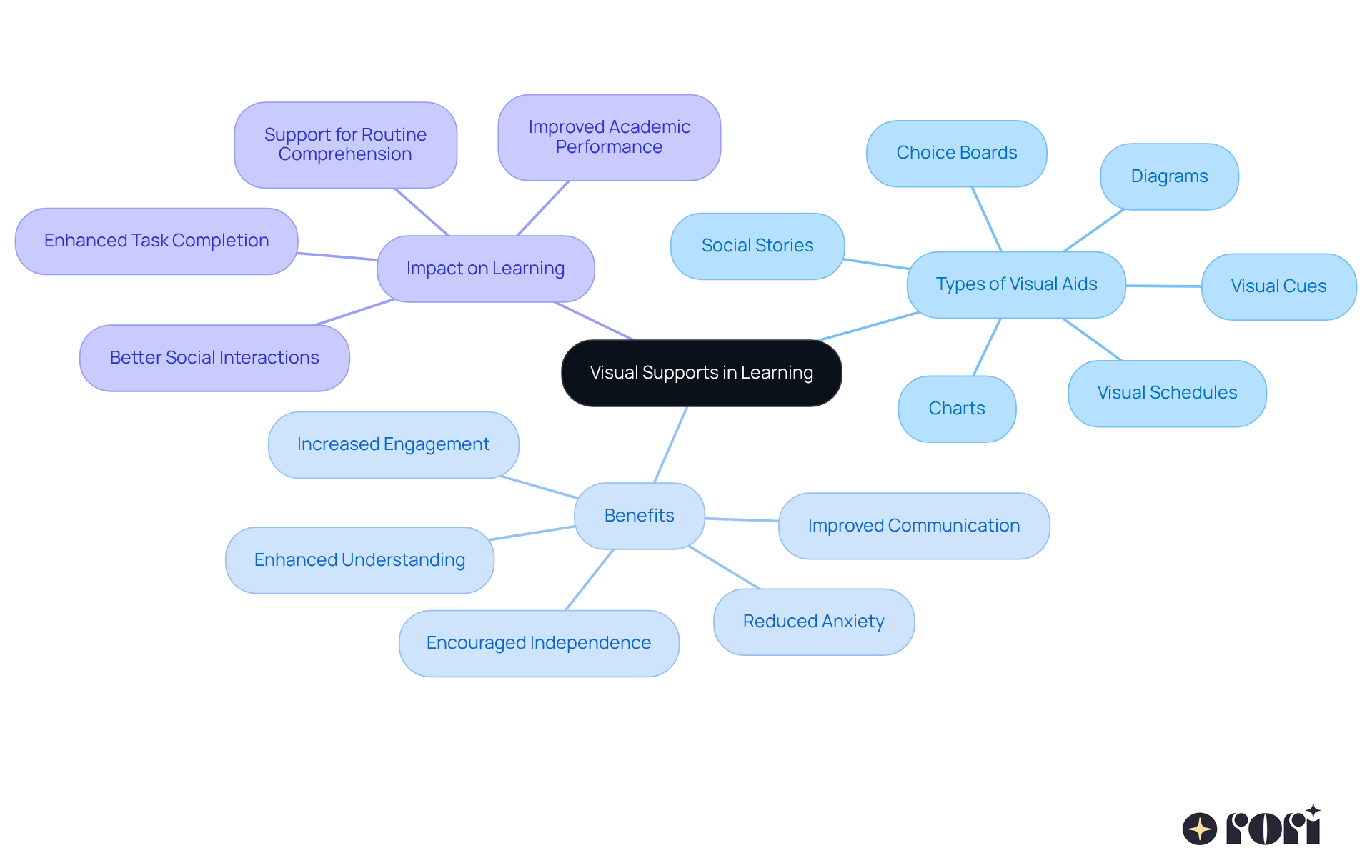
Collaboration is so important for creating a supportive learning environment for individuals with autism. When therapists, educators, and families come together, they form a strong support system that meets both academic and behavioral needs. Regular chats and shared goals among everyone involved help ensure that children get consistent support in different settings.
For instance, consider a teacher collaborating with a therapist to implement ABA therapy for improving academic skills in the classroom. This teamwork reinforces the skills kids learn during therapy sessions. It’s a win-win! Not only does this approach boost educational outcomes, but it also demonstrates how ABA therapy for improving academic skills helps kids transfer those skills to various situations, leading to better performance in their studies.
Successful support networks really thrive on interdisciplinary collaboration. When families are engaged in the educational process and communication flows freely, it can make a huge difference in how effective interventions are. Research shows that individuals with autism who experience collaborative approaches often see significant improvements in their academic achievements through ABA therapy for improving academic skills. These strategies create a more inclusive and supportive learning atmosphere.
Experts agree that building these networks takes a commitment to understanding each child’s unique needs and strengths. By tapping into the expertise of therapists and educators, families can create tailored support systems that include ABA therapy for improving academic skills, helping kids shine both academically and socially.
Let’s explore this together! We’re here to help you every step of the way!

Monitoring Individualized Education Programs (IEPs) is super important for keeping track of how a student is doing with their educational goals. Regular assessments help educators and therapists spot both strengths and areas where a little extra support is needed. Did you know that 67.3% of kids aged 8 with autism have documented eligibility for special education? This really highlights how crucial tailored educational plans are! At Rori Care, we’re excited to use advanced AI technology to automate progress report creation, which gives us 50% more time for direct treatment. This means we can focus more on each individual’s unique needs.
By taking a close look at the data from these assessments, we can make necessary adjustments to the IEP, ensuring it fits with the student’s changing abilities and challenges. For example, if a student is making great strides in reading but struggling with math, we can tweak the IEP to include targeted math interventions. Our behavior care engine is always updating behavior intervention and skill acquisition plans based on the progress made, making sure that treatment plans stay adaptive and effective.
This ongoing assessment process keeps the educational plan relevant and effective, ultimately supporting the student’s academic growth with ABA therapy for improving academic skills. Regular evaluations not only enhance the educational experience but also empower educators and caregivers to make informed choices that cater to each student’s unique needs. Let’s explore this together!
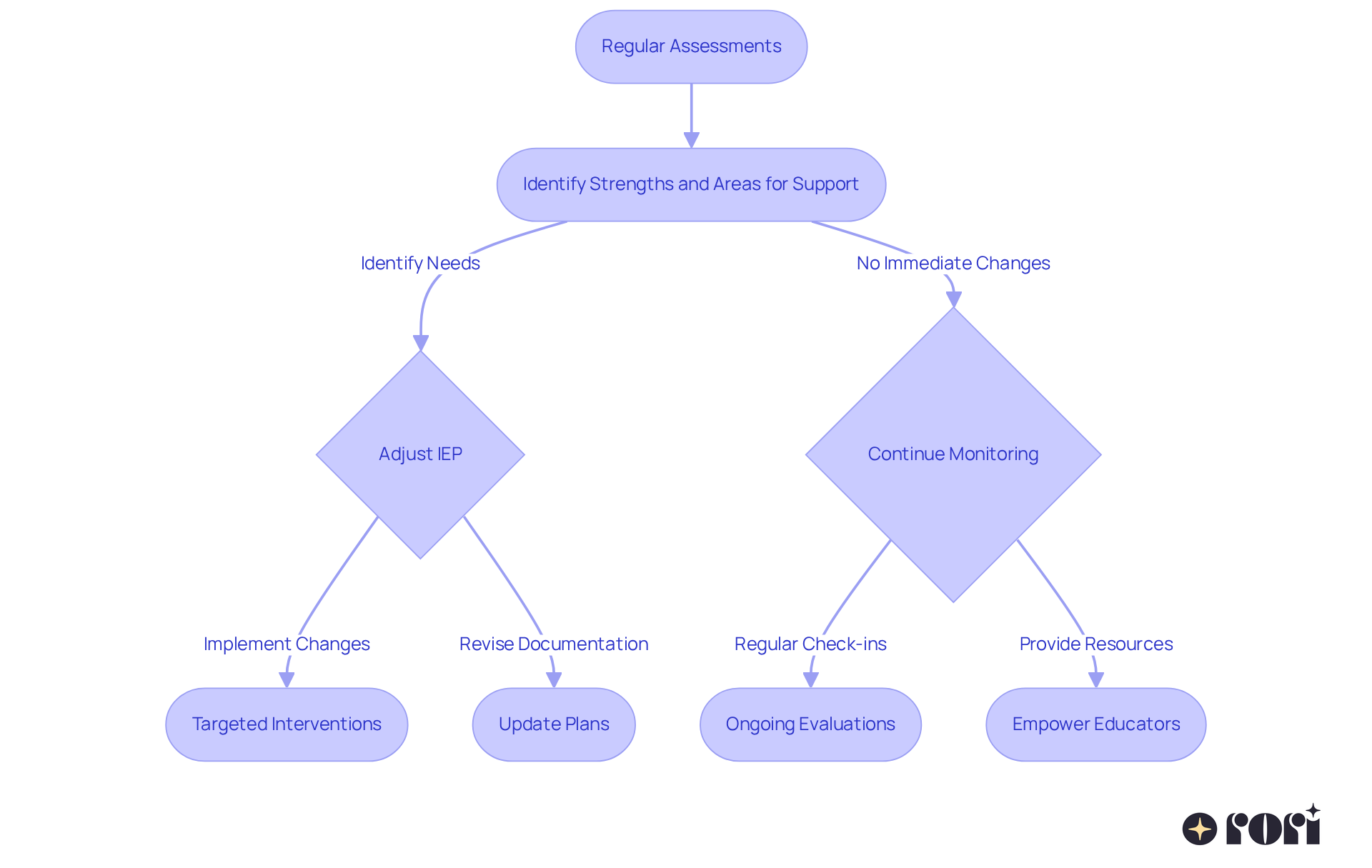
Evidence-based practices are the heart of ABA therapy, making sure that interventions are not just effective but also ethically sound. These practices are rooted in solid research and have consistently shown positive results for individuals with autism. For example, methods like discrete trial training and reinforcement strategies have been backed by extensive studies, proving their significant impact as part of ABA therapy for improving academic skills. By using these research-supported strategies, therapists can really enhance their interventions, leading to better learning experiences and outcomes for young individuals. Plus, incorporating these verified methods, including ABA therapy for improving academic skills, not only boosts academic achievement but also supports the overall growth of essential skills, helping young individuals thrive in educational settings.
When it comes to our program development service, we focus on individualized planning. Each behavioral plan is crafted to fit the unique needs, strengths, challenges, and goals of the client. We set clear, measurable goals for behavior change and skill development, giving everyone a transparent benchmark for progress. Our behavior analysts use evidence-based strategies grounded in the latest research, ensuring we apply the most effective methods for behavior change. And with continuous monitoring and ongoing evaluation, we can tweak the plans as needed to optimize outcomes.
Let’s not forget about caregiver training initiatives! These are crucial for empowering families to actively engage in their child’s treatment, which can really boost the effectiveness of ABA intervention. Caregivers gain a deeper understanding of ABA principles and strategies, which helps them make informed decisions that positively impact their child’s progress. This active involvement often leads to improved behavioral outcomes and gives caregivers a sense of empowerment, enhancing their confidence and reducing stress within the family dynamic. Ethical considerations are also key; personalizing treatment to support autonomy and well-being is vital for creating a positive therapeutic environment.
Statistics show that children receiving intensive ABA therapy for improving academic skills for 25 to 40 hours each week often make significant strides in communication abilities and overall academic success. Early intervention is so important, as starting treatment at a young age usually leads to better outcomes.
As Carl Rogers wisely said, "How can I provide a relationship which this person may use for his own personal growth?" This really highlights the importance of building strong connections in counseling. By following these evidence-based practices, therapists can enhance the effectiveness of their interventions for young individuals, ultimately helping them succeed in educational environments with ABA therapy for improving academic skills.
Let’s explore this together! If you have any questions or thoughts, feel free to share!
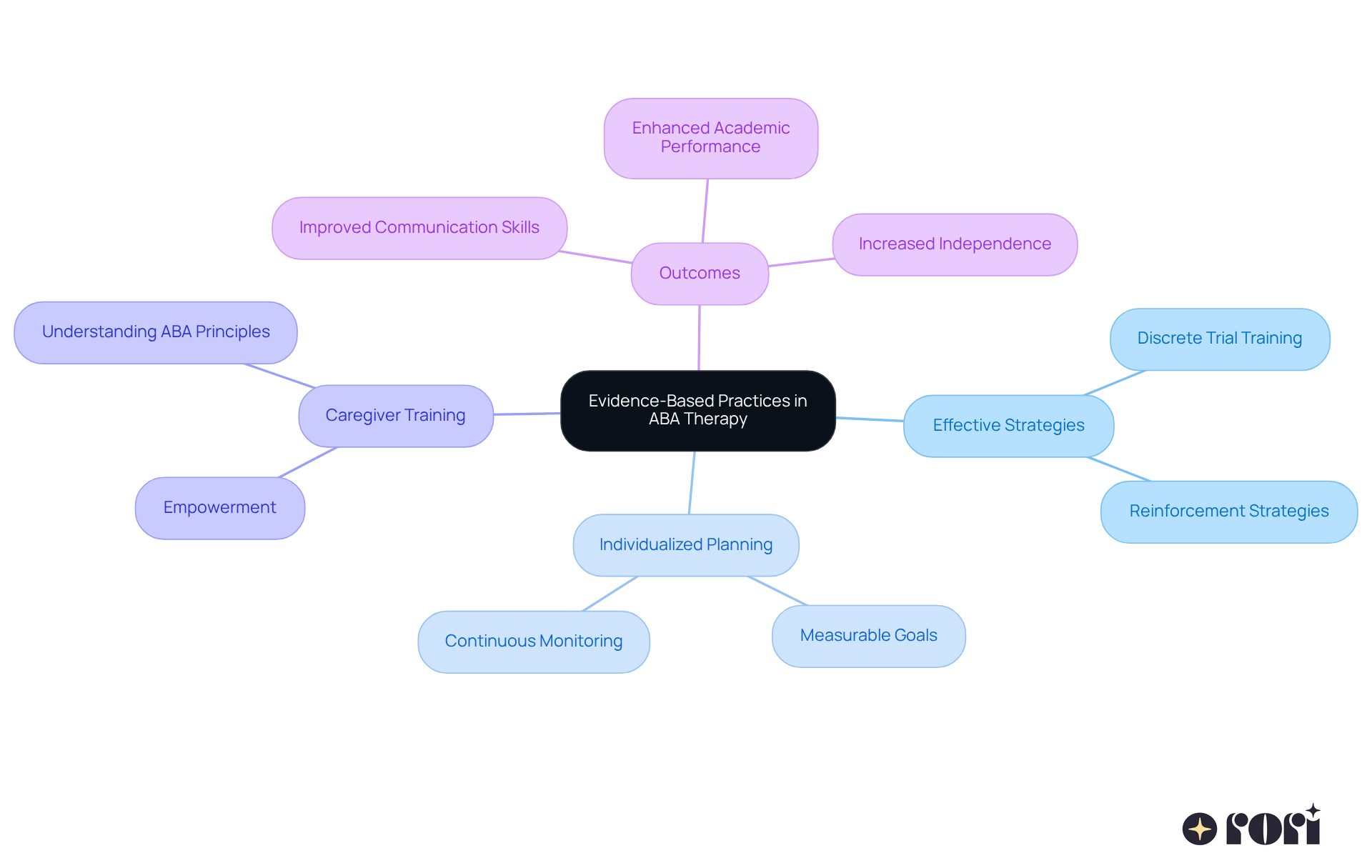
Parental involvement is so important for the success of ABA treatment! When parents actively engage in their child's educational journey, they not only reinforce the skills learned during therapy sessions but also help their kids use these skills in everyday life. This teamwork between parents and therapists creates a stable learning environment, which is key to achieving great results.
For instance, parents can use strategies picked up in therapy, like visual supports or positive reinforcement techniques, to make learning at home even better. This way, parents become advocates for their child's education, ensuring that therapeutic lessons blend seamlessly into daily routines. Research shows that when parents are actively involved, it can really boost developmental outcomes for kids with autism, leading to better communication and social skills.
Plus, it’s not just about how much time parents spend involved; the quality of that involvement matters even more! Tailored participation can lead to significant growth in therapy outcomes. By setting clear, measurable goals and keeping the lines of communication open with therapists, parents can effectively track their child's progress and tweak strategies as needed. This collaborative effort not only nurtures the child's development but also strengthens family bonds, creating a supportive atmosphere that encourages learning and growth.
Let’s explore this together! Remember, you’re not alone on this journey. We’re here to help you every step of the way!
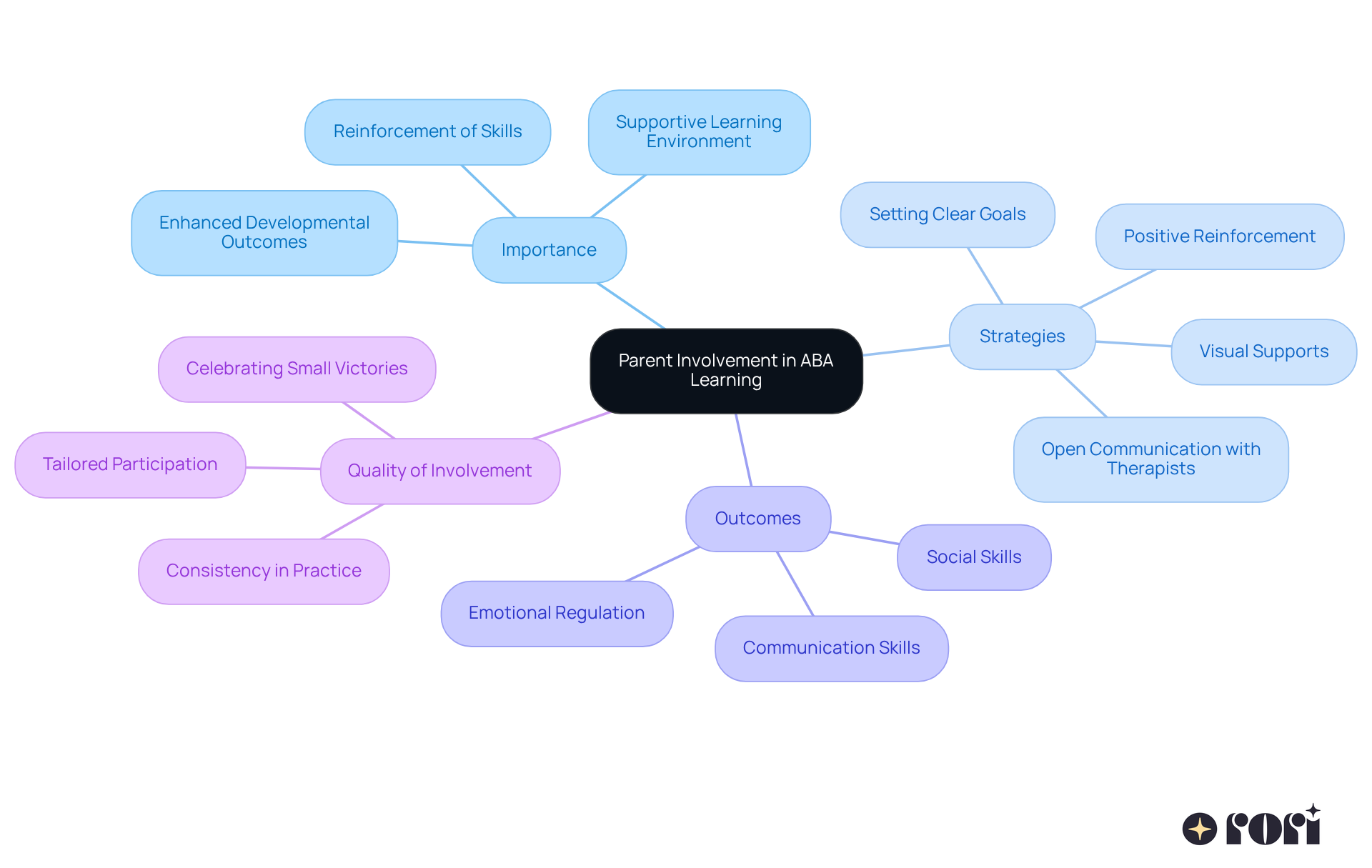
Consistency is key in ABA treatment! When techniques are applied consistently-whether at home, during counseling sessions, or at school-children are much more likely to grasp and internalize the skills being taught. This predictability not only eases anxiety but also creates a sense of safety, allowing young individuals to focus on their learning.
For instance, imagine a young person learning a specific communication method in therapy. If they use that same method at home and in school, it really strengthens their learning. This cohesive approach means that the young learner hears the same messages and expectations everywhere, which helps them acquire skills successfully.
Let’s explore this together! By ensuring consistency across different environments, we can make a real difference in our children's learning journey with ABA therapy for improving academic skills.
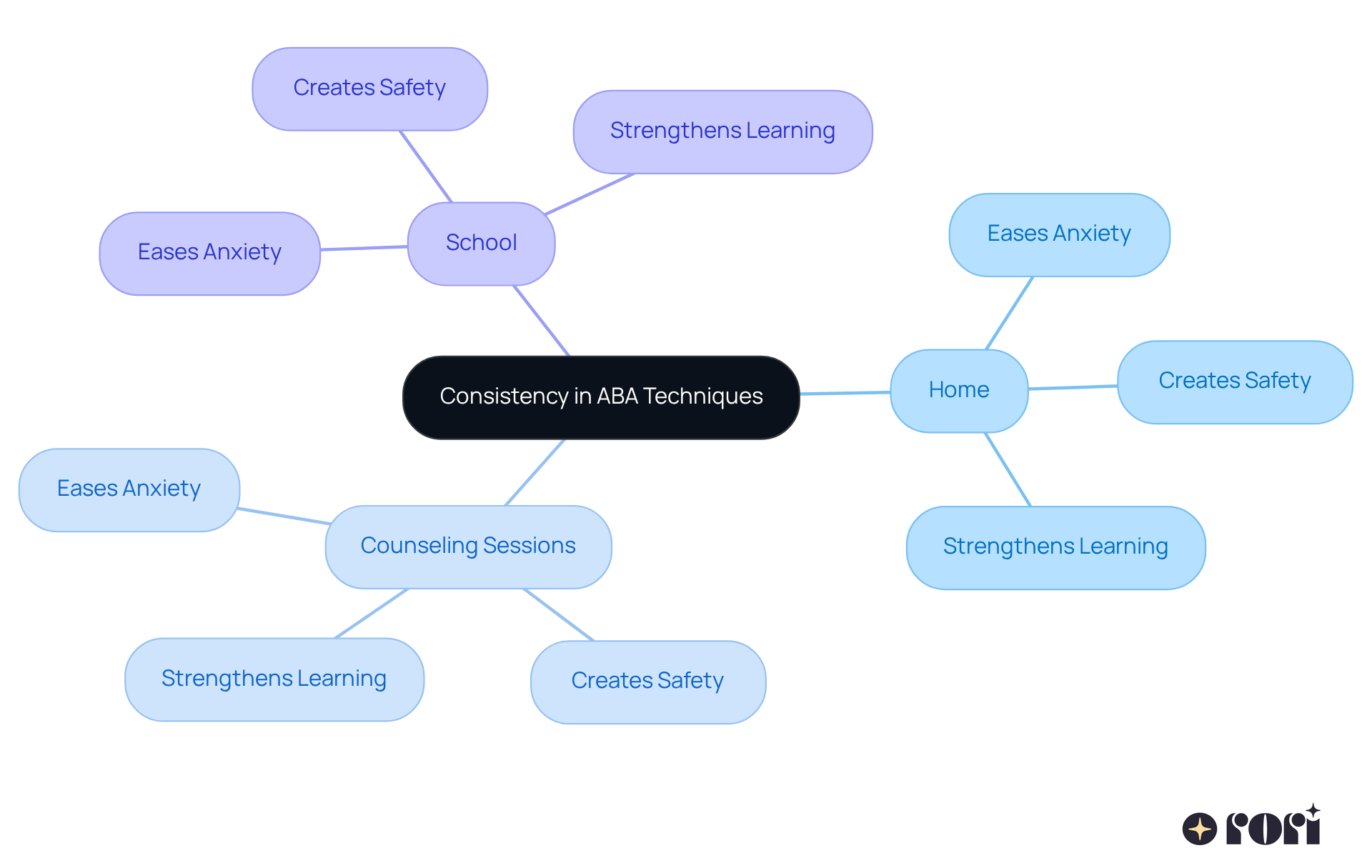
Celebrating progress is such a powerful motivator for young individuals with autism! When we acknowledge their achievements-whether it’s mastering a new skill or showing improved behavior-it really reinforces their efforts and encourages them to keep striving for success. This kind of positive reinforcement not only boosts their self-esteem but also sparks a genuine passion for learning, especially when combined with ABA therapy for improving academic skills.
For example, therapists and parents can set up a fun reward system that recognizes milestones, like completing a challenging task or demonstrating better social skills. Research shows that consistently acknowledging these accomplishments can significantly enhance motivation and self-worth in individuals with autism, especially when combined with ABA therapy for improving academic skills. When we celebrate their achievements, these youngsters feel appreciated and are more motivated to dive deeper into their educational experiences.
Let’s explore this together! How have you celebrated your child’s milestones? We’re here to help you every step of the way!
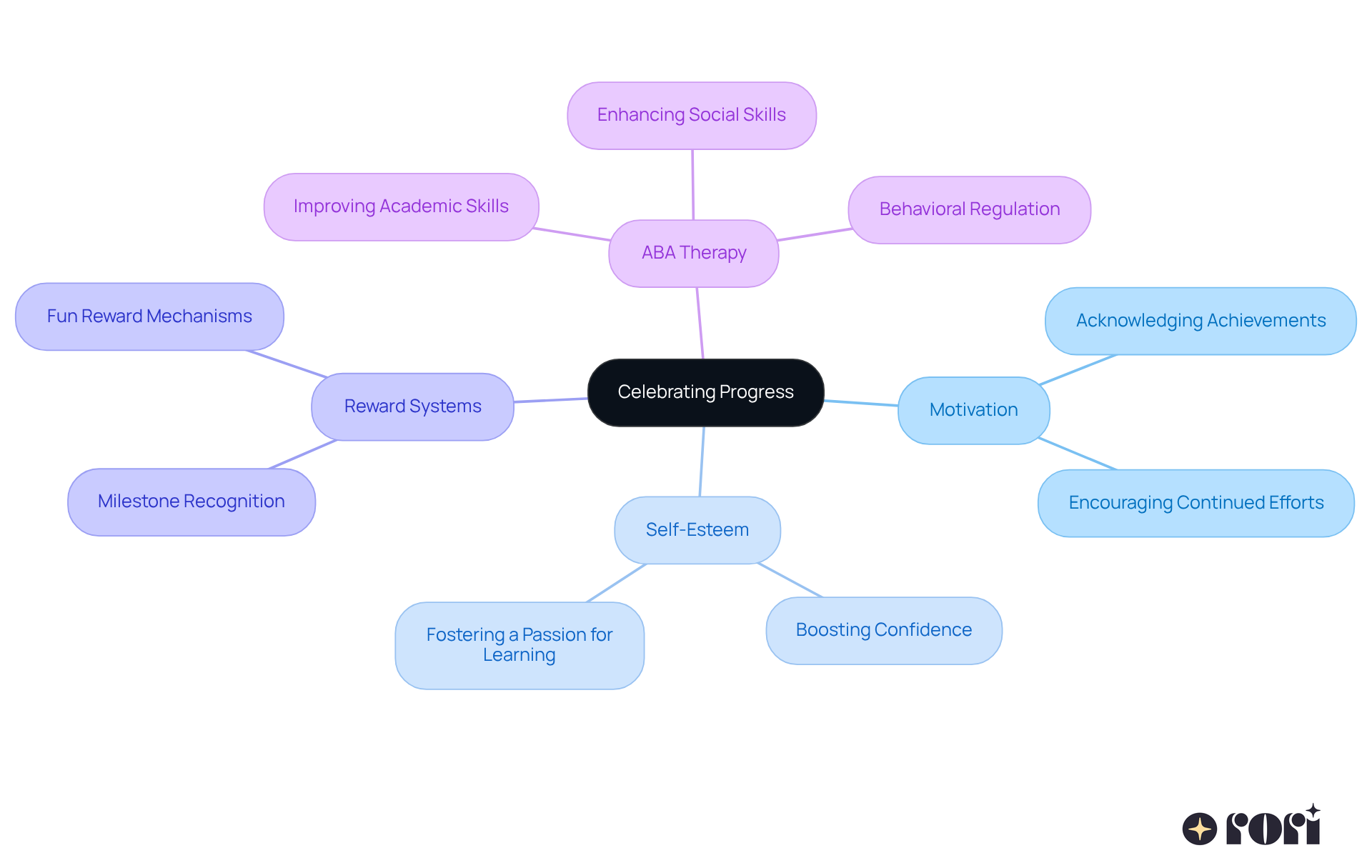
When it comes to helping children with autism, ABA intervention can truly make a difference! This structured, data-driven approach tailors learning to each child's unique needs, which is so important. Not only does it boost communication and social skills, but it also helps kids manage their behavior - key ingredients for success in school and life.
Many parents find that their little ones involved in ABA therapy for improving academic skills often show remarkable improvements in school performance. Kids tend to focus better, retain information more effectively, and tackle problems with newfound confidence. For instance, research indicates that children receiving intensive ABA therapy for improving academic skills often achieve significant gains in various educational tasks, leading to more opportunities to join regular classrooms. Isn’t that encouraging? It’s no wonder that ABA therapy for improving academic skills is regarded as a vital resource for children with autism, paving the way for a brighter academic future and enhancing their overall quality of life.
Let’s explore this together! If you’re considering ABA for your child, know that you’re not alone on this journey. We’re here to help you every step of the way!
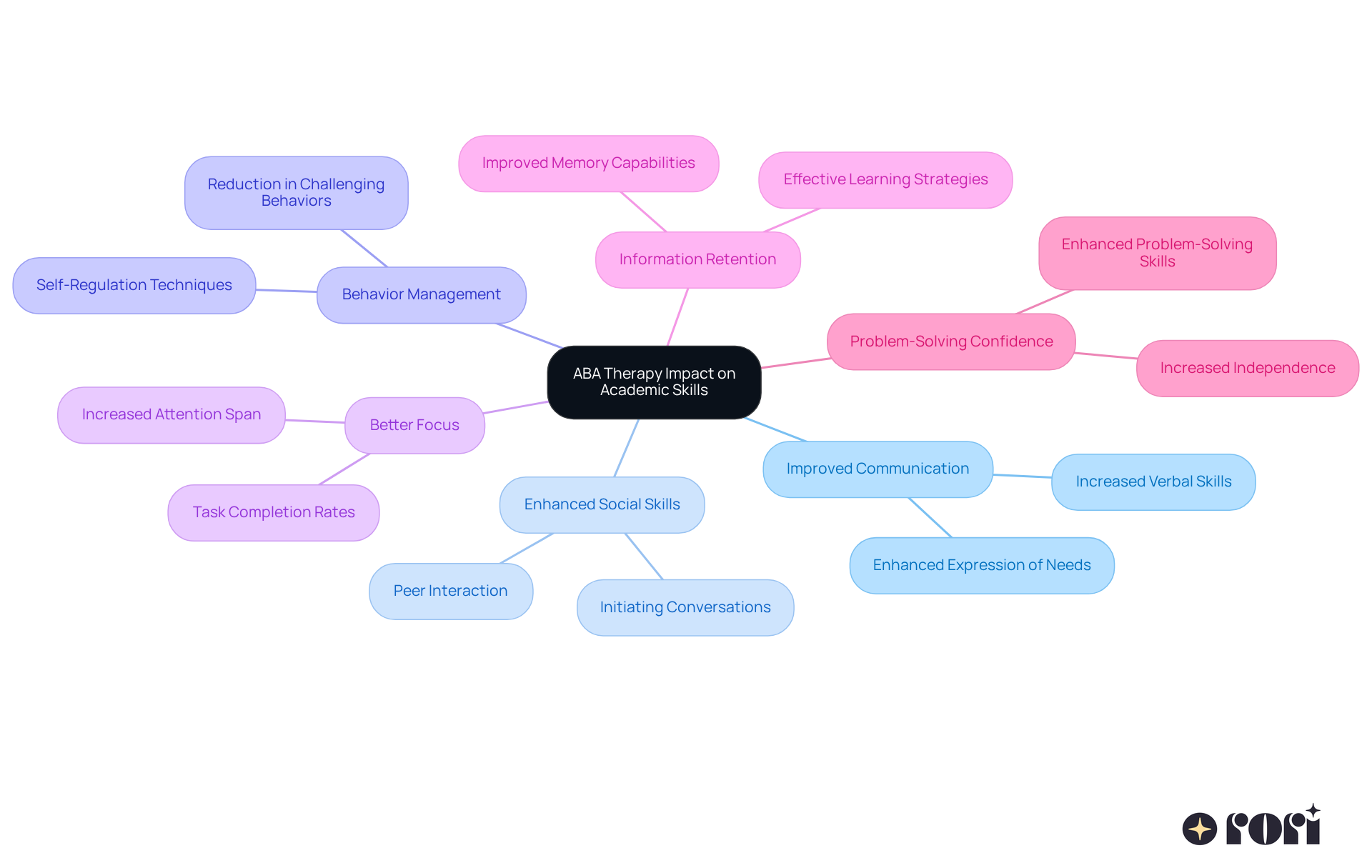
The potential of ABA therapy to boost academic skills for children with autism is truly remarkable! By personalizing and structuring interventions to fit each child's unique needs, ABA therapy not only helps improve educational outcomes but also nurtures essential life skills. This sets the stage for long-term success.
Throughout this journey, we’ve seen key strategies like individualized education plans (IEPs), visual supports, and teamwork among parents, educators, and therapists come into play. These elements work hand in hand to create a supportive learning environment, ensuring that children receive the consistent guidance and encouragement they need to thrive both academically and socially.
But the impact of ABA therapy goes beyond just academics; it empowers children with autism to navigate their educational journeys with confidence and resilience. As families and professionals continue to advocate for tailored support systems, the possibilities for positive change are endless. Embracing these strategies not only enriches the lives of children with autism but also fosters a more inclusive and understanding educational landscape for everyone.
Let’s explore this together! We’re here to help you every step of the way!
What is Rori Care - ABA Therapy?
Rori Care - ABA Therapy provides personalized learning plans using data-driven techniques to support children's unique educational needs through Applied Behavior Analysis treatment.
How does Rori Care tailor its educational plans?
Rori Care evaluates each child's strengths and challenges to develop focused strategies that enhance educational outcomes and promote positive behavior changes, such as improving academic skills.
What is included in the personalized approach to therapy?
The personalized approach may include strategies like visual aids and interactive reading sessions, designed to match each child's learning style and build their confidence.
What is the importance of continuous assessment in therapy?
Continuous assessment ensures that each therapy session is responsive to the child's evolving needs, allowing caregivers to support their loved ones' behavioral goals effectively.
How can ABA therapy impact academic skills?
Research shows that implementing ABA therapy can significantly increase student engagement and improve educational achievement, particularly for young individuals with autism.
What are Individualized Education Programs (IEPs)?
IEPs are tailored plans designed to meet the unique needs of individuals with autism, outlining specific goals, accommodations, and services to support their academic success.
Why is collaboration important in the IEP process?
Collaboration among parents, educators, and therapists creates a powerful support system that understands the individual's strengths and challenges, ensuring the IEP evolves with the person’s growth.
What role do visual supports play in learning?
Visual supports like charts and schedules help break down complex tasks, enhance understanding, reduce anxiety, and encourage independence in individuals with autism.
How do visual aids contribute to educational success?
Regular use of visual aids enhances understanding and retention, leading to better performance in studies and a more effective learning environment.
How can parents get support while navigating these educational challenges?
Rori Care is available to help parents every step of the way, offering guidance and support in navigating ABA therapy, IEPs, and the use of visual supports.